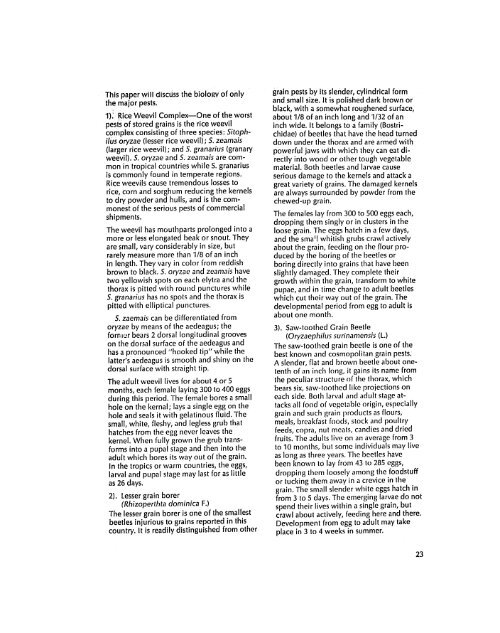I AR Pest control - USAid
I AR Pest control - USAid
I AR Pest control - USAid
Create successful ePaper yourself
Turn your PDF publications into a flip-book with our unique Google optimized e-Paper software.
This paper will discuss the biolov of only<br />
the major pests.<br />
1). Rice Weevil Complex-One of the worst<br />
pests of stored grains isthe rice weevil<br />
complex consisting of three species: Sitophilus<br />
oryzae (lesser rice weevil); S.zeamais<br />
(larger rice weevil); and S.granarius (granary<br />
weevil). S.oryzae and S.zearnais are common<br />
in tropical countries while S.granarius<br />
iscommonly found in temperate regions.<br />
Rice weevils cause tremendous losses to<br />
rice, corn and sorghum reducing the kernels<br />
to dry powder and hulls, and isthe commonest<br />
of the serious pests of commercial<br />
shipments.<br />
The weevil has mouthparts prolonged into a<br />
more or less elongated beak or snout. They<br />
are small, vary considerably in size, but<br />
rarely measure more than 1/8 of an inch<br />
in length. They vary in color from reddish<br />
brown to black. S.oryzae and zeamais have<br />
two yellowish spots on each elytra and the<br />
thorax ispitted with round punctures while<br />
S.granarius has no spots and the thorax is <br />
pitted with elliptical punctures. <br />
S.zaemais can be differentiated from<br />
oryzae by means of the aedeagus; the<br />
fornur bears 2 dorsal longitudinal grooves<br />
on the dorsal surface of the aedeagus and<br />
has a pronounced "hooked tip" while the<br />
latter's aedeagus is smooth and shiny on the<br />
dorsal surface with straight tip.<br />
The adult weevil lives for about 4or 5<br />
months, each female laying 300 to 400 eggs<br />
during this period. The female bores asmall<br />
hole on the kernal; lays a single egg on the<br />
hole and seals it with gelatinous fluid. The<br />
small, white, fleshy, and legless grub that<br />
hatches from the egg never leaves the<br />
kernel. When fully grown the grub transforms<br />
into a pupal stage and then into the<br />
adult which bores its way out of the grain,<br />
In the tropics or warm countries, the eggs,<br />
larval and pupal stage may last for as little<br />
as 26 days.<br />
2). Lesser grain borer<br />
2). Leser dominica F.)<br />
(Rhizoperthta dspend<br />
The lesser grain borer isone of the smallest<br />
beetles injurious to grains reported in this<br />
country. It is readily distinguished from other<br />
grain pests by its slender, cylindrical form<br />
and small size. It is polished dark brown or<br />
black, with a somewhat roughened surface,<br />
about 1/8 of an inch long and 1/32 of an<br />
inch wide. It belongs to a family (Bostrichidae)<br />
of beetles that have the head turned<br />
down under the thorax and are armed with<br />
powerful jaws with which they can eat directly<br />
into wood or other tough vegetable<br />
material. Both beetles and larvae cause<br />
serious damage to the kernels and attack a<br />
great variety of grains. The damaged kernels<br />
are always surrounded by powder from the<br />
chewed-up grain.<br />
The females lay from 300 to 500 eggs each,<br />
dropping them singly or in clusters in the<br />
loose grain. The eggs hatch in afew days,<br />
and the small whitish grubs crawl actively<br />
about the grain, feeding on the flour produced<br />
by the boring of the beetles or<br />
boring directly into grains that have been<br />
slightly damaged. They complete their<br />
growth within the grain, transform to white<br />
pupae, and in time change to adult beetles<br />
which cut their way out of the grain. The<br />
developmental period from egg to adult is<br />
about one month.<br />
3). Saw-toothed Grain Beetle<br />
(Oryzaephilus surinamensis (L.)<br />
The saw-toothed grain beetle isone of the<br />
best known and cosmopolitan grain pests.<br />
A slender, flat and brown beetle about onetenth<br />
of an inch long, it gains its name from<br />
the peculiar structure of the thorax, which<br />
bears six, saw-toothed like projections on<br />
each side. Both larval and adult stage attacks<br />
all food of vegetable origin, especially<br />
grain and such grain products as flours,<br />
meals, breakfast foods, stock and poultry<br />
feeds, copra, nut meats, candies and dried<br />
fruits. The adults live on an average from 3<br />
to 10 months, but some individuals may live<br />
as long as three years. The beetles have<br />
been known to lay from 43 to 285 eggs,<br />
dropping them loosely among the foodstuff<br />
or tucking them away in a crevice in the<br />
grain. The small slender white eggs hatch in<br />
from 3 to 5 days. The emerging larvae do not<br />
their lives within asingle grain, but<br />
crawl about actively, feeding here and there.<br />
Development from egg to adult may take<br />
place in 3 to 4 weeks in summer.<br />
23

















